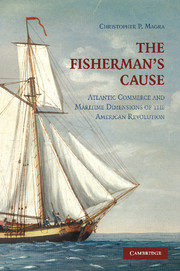Book contents
- Frontmatter
- Contents
- Acknowledgments
- Abbreviations
- Introduction
- Part One THE RISE OF THE COLONIAL COD FISHERIES
- Part Two ATLANTIC ORIGINS OF THE AMERICAN REVOLUTIONARY WAR
- Part Three THE MILITARY MOBILIZATION OF THE FISHING INDUSTRY
- 8 From Trade Routes to Supply Lines
- 9 The First American Navy
- 10 Starving the Enemy and Feeding the Troops
- 11 From Fishermen to Fighting Men
- Conclusion
- Index
- References
8 - From Trade Routes to Supply Lines
Published online by Cambridge University Press: 03 July 2009
- Frontmatter
- Contents
- Acknowledgments
- Abbreviations
- Introduction
- Part One THE RISE OF THE COLONIAL COD FISHERIES
- Part Two ATLANTIC ORIGINS OF THE AMERICAN REVOLUTIONARY WAR
- Part Three THE MILITARY MOBILIZATION OF THE FISHING INDUSTRY
- 8 From Trade Routes to Supply Lines
- 9 The First American Navy
- 10 Starving the Enemy and Feeding the Troops
- 11 From Fishermen to Fighting Men
- Conclusion
- Index
- References
Summary
Sundry Vessels belonging to North America go to the French, Dutch & Danish Islands in these Seas, & offer unlimited prices for Gunpowder&other Warlike Stores. … the vast price offered may tempt the [West Indian] Proprietors to run risks & dispose of it, which must prove of the utmost disservice to His Majesty by thus assisting the North Americans, who are now declared to be in open Rebellion.
Vice Admiral James Young, commander of the British naval squadron in the West Indies, was very aware that there were vessels bound from the North American mainland colonies entering his jurisdiction to trade illegally for military stores necessary to supply a revolution. Young had been stationed between a rock and a hard place in 1775. On the one hand, commercial vessels owned by law-abiding merchants loyal to Crown and Parliament entered and left his seas on a regular basis. As long as they had the proper papers, this trade was entirely legal, and Young had an obligation to protect and preserve such commerce. On the other hand, New England had been declared in a state of rebellion, and the British government expressly ordered Young to prevent the rebels from obtaining military stores in the West Indies. It was, therefore, left to the naval commander to discern one vessel from the next and to keep arms and ammunition out of New England.
- Type
- Chapter
- Information
- The Fisherman's CauseAtlantic Commerce and Maritime Dimensions of the American Revolution, pp. 161 - 176Publisher: Cambridge University PressPrint publication year: 2009



